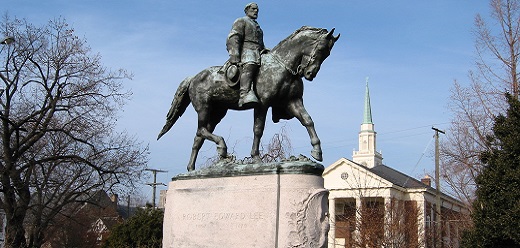
before it was covered, awaiting removal.
https://commons.wikimedia.org/wiki/File:Lee_Park,_Charlottesville,_VA.jpg
The recent controversy over the removal of many Confederate statues from cities across the U.S. South has triggered a debate over the value of History and public memory, and the symbolic meaning of monuments, which has witnessed the contribution of journalists and scholars in all the major papers. The roots of the debate are in the decision taken by several mayors and city governments in the South in the past year and a half to remove statues representing Confederate Generals – notably Robert E. Lee and “Stonewall” Jackson – from public places such as squares and parks, where they may be seen as offensive monuments linked to idea of white supremacy. The planned removals of the statues sparked a great deal of protests, particularly among right-wing activists.
Protests reached a boiling point at Charlottesville, Virginia, when, on August 12-13, extreme right-wing groups including members of the Ku Klux Klan, skinheads, and Neo-Nazis converged in a massive rally and clashed against their opponents who defended the right to remove the Confederate statues because they represented offensive symbols for African Americans. After the clashes led to the death of a civil rights activist – Heather D. Heyer – deliberately run over with a car by an extreme right-wing protester, it seemed to many that the United States was again engulfed in an atmosphere of political extremism and racial hatred which could explode in a new civil war – especially as a result of the distinctive impression of a lack of moral leadership from the current U.S. President, Donald Trump [The New Yorker].
In truth, both the issue of the removal of Confederate statues and the demonstrations in Charlottesville, with their tragic outcome, have shown the difficulty, if not the impossibility, of disentangling the intricacies of southern history, whose different layers are often collapsed together into a single narrative – a narrative which speaks volumes about the overarching legacy of slavery and racism as a clear link between the past and the present. In fact, at different times, the Confederate statues present in many southern cities have served the purpose of reinforcing the idea and practice of racial supremacy of whites over African Americans and also over Jews and other minorities, right from the moment the statues were erected and put in place and up to the recent disturbances.
From this perspective, if we think that these statues are ubiquitous in cities across the U.S. South and we notice that they had not been a major issue until recently, we would be entitled to ask, as Columbia University’s historian Eric Foner has done in an interview in The Nation “how much regime change there actually has been in [the United States] since the Civil War”, and specifically what really changed in the South before the last year-and-a-half ? The simple answer to both these questions is: very little in terms of public memory, since there is a clear, 150-year long, line of continuity between the racist ideology that the statues of defeated Confederate generals represent and the recent attempts to protect the memory and legacy of that ideology by right-wing extremists.
The Confederate Statues and Jim Crow
While the statues at the heart of the controversy represent Confederate generals, they were erected long after the fall of the Confederacy at the end of the American Civil War. According to statistics published by the Southern Poverty Law Center, of the more than 1,500 symbols of the Confederacy present in American cities, the large majority of the 700 monuments and statues of Confederate leaders were put in place between the 1890s and the 1920s; for example, Robert E. Lee’s statue in Charlottesville has stood over Lee Park (renamed Emancipation Park in 2017) since 1924.
This chronology is of enormous significance, since the period between the 1890s and the 1920s witnessed the peak of the Jim Crow system of racial segregation in the U.S. South, with laws discriminating against African Americans in every aspect of their daily life and with the highest number of lynching of blacks in the twentieth century. Equally significant is the fact that the next, and last, outburst in construction of Confederate monuments occurred in the 1960s, at the time of the Civil Rights Movement, which challenged the Jim Crow system and eventually led to its dismantlement. Thus, the Confederate statues are inextricably linked, in their origin, to the assertion of racial supremacy of white southerners over African Americans: their legacy has as much to do with twentieth-century racism as with nineteenth-century slavery and the American Civil War.
The Confederate Statues and the “Lost Cause”
Insofar as there is a historical connection between the Confederate statues and the individuals they represent, the link relates to a late nineteenth-century rewriting of history through the creation of the myth of the “Lost Cause” as a widespread interpretation of the Confederacy’s role in the American Civil War among white southerners until the 1950s. Even though, as historian Jane Turner Censer has remarked, monuments honouring the Confederate dead existed from the 1860s, these mostly honoured the sacrifice of fallen soldiers with no specific image attached. Only with the 1894 creation of the Daughters of the Confederacy, an association specifically dedicated to perpetuate the memory of the Confederate leaders as noble and virtuous, the monuments that honoured the Confederate war effort became mostly portrayals of Confederate generals – rather than unknown or common soldiers – usually in poses reminiscent of the classical statues of heroes.
There is a clear link, therefore, between the erection of statues of Confederate generals and the manufacturing of the myth of the “Lost Cause” – i.e., the idea that the Confederacy was a noble, but doomed, enterprise, for which valiant and gentlemanly knights fought against impossible odds for the sake of asserting their right to self-government and for the protection of their way of life. In this way, the myth of the “Lost Cause” reinforced the white supremacist narrative by making heroes of slaveholders, and by justifying as normal a racist social order based on the enslavement of African Americans as a prelude to Jim Crow.
The Confederate Statues and Racism/Neo-Nazism
Interlinked with the two historical layers represented by the failed Confederate protection of slavery and by the Jim Crow system of racial segregation is a third historical layer associated to the Confederate statues: it is represented by the continuing historical legacy of extreme twentieth-century racist oppression, which reached its peak worldwide with the Nazi regime in 1933-45. As historian Nina Silber has pointed out in the Washington Post, it is no mystery that Adolf Hitler praised the racial order in the U.S. South and decried the Confederate defeat in the American Civil War. In fact, there were many similarities between the ways in which Nazi Germany and the Jim Crow South maintained racial supremacy through a great deal of violence. Moreover, after its second foundation, in 1915, the Ku Klux Klan had greatly expanded the scope of its actions, moving beyond the South into other areas of the United States and including as targets of its murderous activities not just African Americans, but also Catholics and Jews, all classed together as threats to the supposed “White Anglo-Saxon Protestant” norm in America.

Thus, it is not difficult to see how the two most extreme regimes of racial oppression in the twentieth century – 1920s America and 1930s Germany (though we should include also Apartheid South Africa) – have enough in common to claim an ideological affiliation to the Confederate statues and the ideology of white supremacy they represent. For this reason, in Charlottesville, the Alt-Right extremists conducted their protest against the removal of those statues amidst a great many Confederate flags and Nazi swastikas, linking Neo-Confederates and Neo-Nazis in great racist crusade to rescue the white supremacist narrative of southern history, and world history, from being obliterated from public memory.
President Trump and U.S. Historians
In the wake of the events at Charlottesville, U.S. President Donald Trump issued a statement condemning violence “on many sides”, right and left, thus downplaying the obvious fact that the murderous action leading to the death of peaceful demonstrator Heather Heyer and injuring nineteen more had been carried out by a Neo-Nazi called James Alex Fields, Jr. Unsurprisingly, Trump’s comment led many to notice, not for the first time, the absence of a credible moral leadership in the country. Even more significant, though, was another comment that Trump made, decrying the removal of the Confederate statues and asking provocatively if also the statues of George Washington and Thomas Jefferson would be removed. This comment prompted a great deal of reaction among U.S. historians, who mostly defended the decision to remove Confederate statues, either to destroy them or to place them in museums with explanations on their historical context, while they also condemned Trump’s stance as another proof of his ignorance of American History [see the official statement released by the American Historical Association].
Specifically, a majority of historians has strongly criticized Trump for grouping together the Confederate leaders with Washington and Jefferson, and thus for considering treasonous rebels who fought against the United States on the same level as the Founding Fathers of the American nation. Yet, leaving aside Trump’s historical ignorance, there are other important elements to consider on this issue, since it is no mystery that both Washington and Jefferson shared with the Confederate leaders the fact that they all owned large numbers of African American slaves. Therefore, it would seem to be the case that, as Tim Messer-Kruse has written in Counter Punch Magazine, “equating Confederates with the problem of racism and Founders with a failed but noble color-blind progressivism has long served to insulate American government and American society from the sort of deep and critical examination of racist practices that any true belief in equality would require.” In truth, though, these are still very sensitive issues, almost two-hundred-and-fifty years after Washington and Jefferson and more than one hundred and fifty years after the defeat of the Confederacy. A thorough acknowledgment of the pervasive legacy of slavery and racism in the United States from the time of its foundation is not yet part of the prevalent narrative of American History in books and media.
The statues of Robert E. Lee and “Stonewall” Jackson in Charlottesville have now been covered in black tarpaulin as a sign of mourning for the loss of human lives they caused, and are still awaiting a final decision over their removal, together with many other Confederate statues across the South. Meanwhile, the polarization of the debate and the violent clashes between extremists that led to a death in Charlottesville have reminded some – among them historian David Blight – of the political extremisms that characterized the decade of the 1850s, just before the Civil War, significantly also a decade lacking in terms of both moral and political leadership, before the 1860 election of Abraham Lincoln to the presidency. And in truth, the legacy of the American Civil War, fought by the Confederacy to protect slavery, is as important a part of the present-day identity of the South as the historical legacy of racism. At the same time, it also represents an eternal warning about how the American nation may again rip itself apart over issues that can cause an “irrepressible conflict” – in the famous words uttered in 1858 by Lincoln’s future Secretary of State, William H. Seward.[1]
Not accidentally, two of the most celebrated and innovative novels by American authors in the past two years have focused on an alternative present in which slavery has not been abolished – as in Ben H. Winters’ Underground Airlines (2016)[2] – and therefore the issue that has caused the Civil War has not been resolved, and on a dystopian future in which some southern states revolt against a ban on fossil-fuel causing a second American Civil War, much more technologically advanced and devastating than the first one – as in Omar El Akkad’s American War (2017).[3] Both Winters’ and El Akkad’s books speak to deep-seated anxieties in American society, which the issue of Confederate statues – coming at the end of a three-year period of shocking episodes of murderous racism culminating it the 2014 shooting of Michael Brown and the following riots in Ferguson, Missouri, and in the 2015 massacre of worshippers in the Emanuel African Methodist Episcopal Church in Charleston, South Carolina, and in the midst of a highly divisive political atmosphere caused by the recent presidential election – have contributed to heighten by being symbols of the continuous southern historical legacy of slavery, racism, and white supremacy.
Notes
[1] William Henry Seward, “The Irrepressible Conflict (Rochester, October 25, 1858)” in George E. Baker, ed., Works of William Henry Seward, Vol. 4 (Boston: Houghton Mifflin, 1887), pp. 289-302.
[2] Ben H. Winters, Underground Airlines, Boston: Little, Brown, 2016.
[3] Omar El Akkad, American War, New York: Alfred A. Knopf, 2017.


